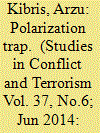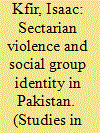| Srl | Item |
| 1 |
ID:
132201


|
|
|
|
|
| Publication |
2014.
|
| Summary/Abstract |
Al-Shabaab, the Somali militia currently fighting against African forces in Somalia, has seen varying degrees of success in its regional recruitment efforts. As it continues to struggle against the forces of the African Union Mission in Somalia (AMISOM), the militia has tried to step up these efforts. To this end, the group has seen significant success in countries such as Kenya, while it has struggled in Somaliland. The strategies and tactics employed by al-Shabaab in order to successfully recruit vary depending on geographical location, as do the motivations to join, and drawing on fieldwork in both Kenya and Somaliland this study will compare and contrast the effectiveness al-Shabaab recruitment in both of these countries. In doing so, it will examine which local conditions either enhance or limit these efforts, identifying some of the determinants of the success and failure of jihadist recruitment in east Africa.
|
|
|
|
|
|
|
|
|
|
|
|
|
|
|
|
| 2 |
ID:
132200


|
|
|
|
|
| Publication |
2014.
|
| Summary/Abstract |
This article studies the association between ethnic conflicts and political attitudes. It employs a new data set on the casualties of the ethnic conflict in Turkey to identify the effects of the Kurdish insurgency on the electoral behavior of the Turkish voters. The results indicate that the conflict leads to the political polarization of the society along ethnic nationalist lines. Further investigation of the data also provides some empirical support for the constructivist argument that the salience of ethnic identities is subject to change in response to external stimuli, of which ethnic conflict constitutes a drastic example.
|
|
|
|
|
|
|
|
|
|
|
|
|
|
|
|
| 3 |
ID:
132198


|
|
|
|
|
| Publication |
2014.
|
| Summary/Abstract |
Why do ethnic conflicts spread to neighboring states? This article examines the effect of transborder ethnic groups on the spread of ethnic conflict. It argues that when a transborder ethnic group is in conflict in one state, neighboring states perceive a threat from members of that ethnic group residing in their own territory, leading the state to take preemptive repressive action. This repression in turn changes the ethnic group's security situation within the state and can result in violence and thus ethnic conflict. Ethnic conflict spread is not determined by the actions of either the ethnic group or the state alone, but is a product of threat perception and interaction between the two groups. This argument is tested in a set of cases in a region where an ethnic conflict seems to have spread-the Kurds in Iran, Iraq, Syria and Turkey from 1961-2003.
|
|
|
|
|
|
|
|
|
|
|
|
|
|
|
|
| 4 |
ID:
132197


|
|
|
|
|
| Publication |
2014.
|
| Summary/Abstract |
Individual basic security is limited in Pakistan as the state is institutionally weak. One way to attain basic security is by joining groups who provide security and services. Consequently, groups not part of the political mainstream, to attract a following, must therefore show that they are sufficiently powerful to obtain concessions from established actors. Thus, by engaging in violence primarily of a sectarian nature, the Pakistani Taliban sustains itself as a unified force while also highlighting that it is a powerful group, which in turn it hopes would enable it to curve a political space and win concessions from the established elite. Using social group identity theory, club goods, and the economics of extremism, the article highlights why the Pakistani Taliban has increasingly attacked minorities and why more must be done to address sectarian violence.
|
|
|
|
|
|
|
|
|
|
|
|
|
|
|
|